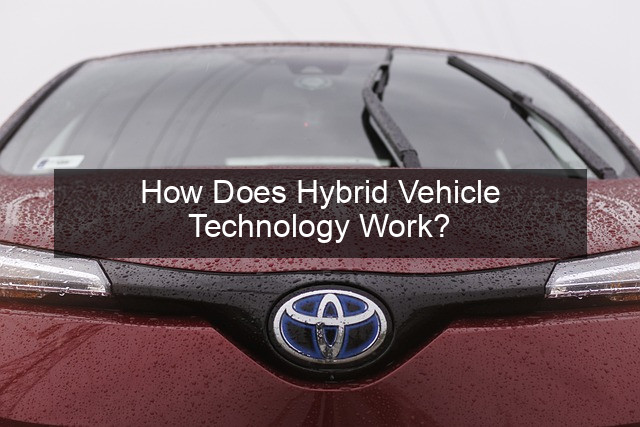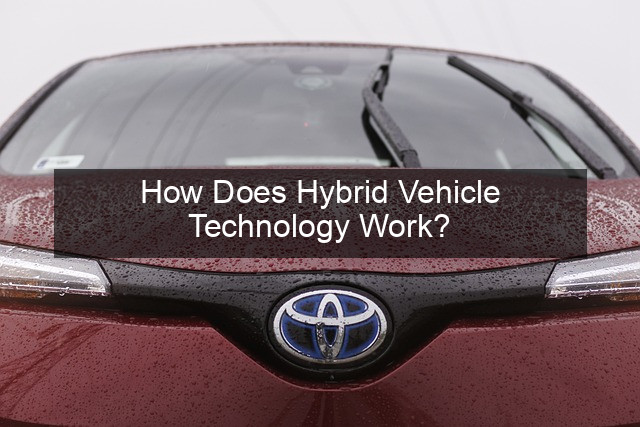How Does Hybrid Vehicle Technology Work?

- How Does Hybrid Vehicle Technology Work?
- How Does Hybrid Vehicle Technology Work?
- Types of Hybrid Vehicles
- Series Hybrids
- Parallel Hybrids
- Plug-in Hybrids
- Key Components of a Hybrid System
- Electric Motor
- Gasoline Engine
- Battery Pack
- Power Split Device
- Benefits of Hybrid Technology
- Fuel Efficiency
- Reduced Emissions
- Performance Enhancements
- Conclusion
- Frequently Asked Questions

How Does Hybrid Vehicle Technology Work?
The automotive world is undergoing a significant transformation, driven by the need for sustainable and efficient transportation. At the forefront of this change are hybrid vehicles, combining the strengths of traditional gasoline engines with the eco-friendly advantages of electric motors. These vehicles offer a compelling bridge between conventional cars and fully electric options, appealing to drivers seeking improved fuel efficiency and reduced emissions without the range anxiety associated with pure EVs. But how exactly does this innovative technology work? This article delves into the intricacies of hybrid vehicle systems, exploring the different types, their core components, and the benefits they offer to both drivers and the environment. Understanding the mechanics behind hybrid technology empowers consumers to make informed decisions in a rapidly evolving automotive landscape.
Types of Hybrid Vehicles
Series Hybrids
Series hybrids, also known as range-extended electric vehicles, utilize the electric motor solely for propulsion. The gasoline engine acts as a generator, charging the battery that powers the electric motor. This configuration offers excellent efficiency in stop-and-go traffic, as the engine can operate at its optimal speed regardless of the vehicle’s speed.
This setup is simpler mechanically than other hybrid types, often resulting in a smoother and quieter driving experience. However, series hybrids typically have lower overall efficiency at higher speeds compared to parallel hybrids.
Some examples of series hybrids include certain models of luxury sedans and compact cars.
Parallel Hybrids
Parallel hybrids employ both the gasoline engine and the electric motor to power the wheels, either individually or in combination. This system offers greater flexibility, allowing the vehicle to utilize the most efficient power source depending on driving conditions.
At low speeds, the electric motor can power the car alone, while at higher speeds, the gasoline engine takes over. During acceleration or when extra power is needed, both the engine and motor can work together.
This configuration is the most common type of hybrid system due to its balance of efficiency and performance.
Plug-in Hybrids
Plug-in hybrid vehicles (PHEVs) combine the benefits of both parallel hybrids and all-electric vehicles. They feature larger batteries that can be charged from an external power source, allowing for extended all-electric driving range.
Once the battery’s charge is depleted, the vehicle operates as a regular parallel hybrid, using the gasoline engine for propulsion and battery recharging. This offers the flexibility of electric driving for shorter trips and the convenience of gasoline for longer journeys.
PHEVs provide a practical stepping stone towards fully electric vehicles, addressing range anxiety concerns while still offering the benefits of hybrid technology.
Key Components of a Hybrid System
Electric Motor
The electric motor is a crucial component, providing propulsion and assisting the gasoline engine. It also acts as a generator during regenerative braking, capturing kinetic energy and converting it into electricity to recharge the battery.
Electric motors are known for their instant torque delivery, contributing to the quick acceleration often experienced in hybrid vehicles.
Their efficiency in stop-and-go traffic makes them ideal for urban driving conditions.
Gasoline Engine
The gasoline engine in a hybrid vehicle is typically smaller and more efficient than those found in conventional cars. It works in conjunction with the electric motor to provide power and, in some cases, recharge the battery.
Modern hybrid engines often incorporate advanced technologies like direct injection and variable valve timing to further enhance efficiency.
The engine’s operation is optimized for specific speed ranges, maximizing fuel economy.
Battery Pack
The battery pack stores the electrical energy used to power the electric motor. It is recharged through regenerative braking and, in some cases, by the gasoline engine.
Battery technology continues to advance, with newer hybrids utilizing more energy-dense and longer-lasting batteries.
The size and capacity of the battery pack determine the vehicle’s all-electric driving range, particularly in plug-in hybrids.
Power Split Device
The power split device is a sophisticated transmission system that seamlessly integrates the power from the gasoline engine and electric motor. It allows for a variety of operating modes, including electric-only, engine-only, and combined power.
This complex system optimizes power delivery for different driving conditions, maximizing efficiency and performance.
The power split device is a key element in the seamless operation of a hybrid vehicle.
Benefits of Hybrid Technology
Fuel Efficiency
Hybrid vehicles significantly improve fuel efficiency compared to their gasoline-powered counterparts. By utilizing electric power at lower speeds and during stop-and-go traffic, they reduce fuel consumption and emissions.
Regenerative braking further enhances efficiency by capturing energy that would otherwise be lost as heat.
This translates to fewer trips to the gas station and lower operating costs for drivers.
Reduced Emissions
Hybrids contribute to a cleaner environment by producing fewer emissions than traditional gasoline vehicles. The use of electric power reduces tailpipe emissions, particularly in urban areas.

Lower emissions contribute to improved air quality and reduced greenhouse gas emissions.
This makes hybrids a more environmentally friendly transportation option.
Performance Enhancements
The electric motor’s instant torque delivery can provide a noticeable boost in acceleration, enhancing the driving experience.
This added power can be particularly beneficial for merging onto highways or passing other vehicles.
Hybrids often offer a surprisingly sporty driving feel, combining efficiency with performance.
Conclusion
Hybrid vehicles represent a significant advancement in automotive technology, offering a compelling blend of efficiency, performance, and environmental responsibility. By understanding the different types of hybrid systems and their core components, drivers can make informed decisions about the best option for their needs and contribute to a more sustainable transportation future.
As technology continues to evolve, hybrid vehicles are poised to play an increasingly important role in the transition towards cleaner and more efficient transportation. The ongoing development of battery technology and powertrain systems promises even greater improvements in range, performance, and affordability, making hybrids an attractive choice for a growing number of drivers.
Frequently Asked Questions
What is the difference between a hybrid and a plug-in hybrid?
A standard hybrid recharges its battery through regenerative braking and the gasoline engine. A plug-in hybrid can also be charged from an external power source, allowing for extended all-electric driving.
How long do hybrid batteries last?
Hybrid batteries are designed to last for the lifespan of the vehicle, often covered by extended warranties. However, factors like usage and climate can affect their longevity.
Are hybrids more expensive to maintain?
Hybrids generally have similar maintenance requirements to conventional vehicles. However, the battery pack may eventually require replacement, which can be a significant expense.
Do hybrids require special fuel?
No, hybrids use regular gasoline just like conventional vehicles.
What are the different types of hybrid systems?
The main types are series hybrids, parallel hybrids, and plug-in hybrids, each with varying configurations of the engine and electric motor.
What is regenerative braking?
Regenerative braking captures the kinetic energy normally lost during braking and converts it into electricity to recharge the battery.
| Hybrid Type | Engine Function | Motor Function |
|---|---|---|
| Series | Generates electricity | Provides propulsion |
| Parallel | Provides propulsion and/or generates electricity | Provides propulsion and/or assists engine |
| Plug-in | Provides propulsion and/or generates electricity | Provides propulsion and/or assists engine |
- Benefit 1: Improved Fuel Efficiency
- Benefit 2: Reduced Emissions
- Benefit 3: Enhanced Performance



